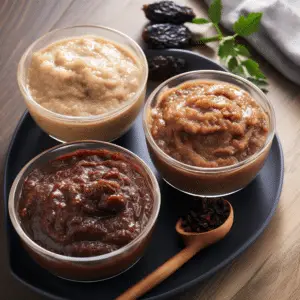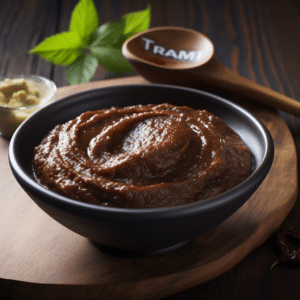
Tamarind Paste vs Puree: Differences and Uses Explained
Tamarind Paste vs Puree: Tamarind fruits are large brown pods containing the tamarind fruit. They come from the tamarind tree, a hardwood fruit tree originating from Africa, and nowadays available in various places, including Mexico and Asia. Tamarind’s sweet and sour taste makes it ideal for multiple culinary uses like chutney and cocktails. Tamarind’s acidity makes it useful in marinades, where it helps to tenderize meat.
There are many forms of tamarind, paste, puree, pulp, concentrate, etc., each having a unique composition profile. However, they both serve the same purpose and are used in culinary. This article discusses tamarind paste vs puree, what they are and their differences.

Tamarind Paste vs Puree: Overview
Both tamarind paste and puree are made from tamarind fruits. However, the former is dryer with little to no moisture and appears semi-solid, while the latter has high moisture content and is a diluted liquid. For this reason, tamarind paste is more concentrated than tamarind puree.
The high concentration makes tamarind paste have an intense tamarind flavor. Similarly, tamarind puree is less concentrated and, therefore, has a mild tamarind flavor.
Since the two come from tamarind, they can be used interchangeably in recipes. But, note that the amount to use will not be the same. So, feel free to use tamarind puree instead of paste if you don’t have the latter in your pantry.
Tamarind paste is more concentrated with an intense flavor. As such, you’ll need a little of it than puree. In contrast, substituting tamarind puree with paste means you’ll use more of it as it’s less concentrated with a mild flavor.
As a step guide to substituting tamarind puree with paste, mix 1 part tamarind paste with 2 parts water. For instance, if your recipe calls for 3 tablespoons of tamarind puree, mix 1 tablespoon of tamarind paste with 2 tablespoons of water. This makes 3 tablespoons of tamarind puree.
Tip: use equal parts of lime juice and dark brown sugar as a substitute if you don’t have tamarind paste and puree. I know this will not give you the typical tamarind taste you’re after, but it will bring a sweet and sour taste to the dish.
Tamarind Paste
There are two forms of tamarind paste. The first one constitutes a brick of well-compressed tamarind pods. This form resembles fig paste in terms of texture and color and contains seeds and pods of the tamarind fruit. Since this paste is compressed into a brick and has a solid form, you have to soak it in water before using it.
Then the second form of tamarind paste is a more ready-to-use product and doesn’t contain seeds or pods. You can find this paste sold in jars labeled as jarred tamarind paste or tamarind concentrate.
Tamarind Puree
Tamarind puree also comes from tamarind fruits. It is more fluid than the paste, with a thickness similar to dripping sauce and texture like apple butter. Like tamarind paste, tamarind puree is also packed in jars and sold in grocery stores. Alternatively, you can make tamarind puree at home.
How To Make Tamarind Paste At Home
Not all people prefer store-bought tamarind paste. The added ingredients and preservatives may interfere with the authentic tamarind taste. Some people also note that store-bought puree is more concentrated than homemade. Here’s a recipe for making tamarind paste at home. This recipe requires tamarind and water.
Procedure
- Tear the tamarind block into tiny pieces using your hands and put it in a microwave-safe bowl. Feel free to use as much or as little tamarind brick as you’d like. Store the remaining tamarind in an airtight container in the fridge.
- Add water to the tamarind block. The water should be enough to submerge the tamarind block barely. Next, microwave the bowl until the water become hot, softening the tamarind. This should take about 1-2 minutes.
- Allow the tamarind to rest at room temperatures for 20-30 minutes until the water is not hot to touch.
- Use your hands to squeeze as much pulp as possible from each tamarind piece. Push the tamarind-water mixture through a cheesecloth or fine-mesh sieve. It’s best to squeeze the tamarind with your hands while pushing it through the sieve. This ensures you have maximum puree yield. Once done, you have tamarind paste.
- Store the tamarind paste in an airtight container. This paste can keep in the refrigerator for 7-10 days. If you want to extend the shelf life of tamarind paste, boil it for 10-15 minutes, and transfer it to a sterilized, airtight container, then place it in the fridge.

How Can You Use Tamarind Paste In Culinary
Tamarind paste is so versatile with a wide range of applications in culinary. It’s best to use in marinating beef steaks, chicken, and fish. The acidity tenderizes the meat, and then sweet and sour flavor enhance the taste of meat. You can also use tamarind paste in stews and curries to give it that sweet-sour kick. Meat and vegetable stews go well with tamarind paste.
Another way of using tamarind paste in culinary is to substitute a little of it with any recipe that calls for acid. For instance, lemon juice, vinegar, and lime juice. This paste is also excellent as a base for salad dressing, chutneys, etc.
Tamarind paste can also be used to make a sauce to dip food in. The dipping sauce can be sweet and sour or hot and sour if you love hot foods. Simply mix the tamarind paste with ground garlic, red onion, chili powder, paprika, salt, and a little sugar. You can skip the chili and sugar part if you don’t fancy them. This sauce is perfect for savory finger-picking foods like skewed or grilled meat, kebabs, fries, samosa, etc.
Sweet applications for tamarind paste include juice, cakes, and cocktails. If you’ve never tried tamarind juice, make a point of giving it a try. This juice hits different, especially during summer when it’s hot.
Conclusion
Tamarind paste and puree are more or less similar and can be used interchangeably in recipes. The former is thicker and more concentrated with an intense flavor, while the latter is fluid-like and less concentrated with a mild taste.